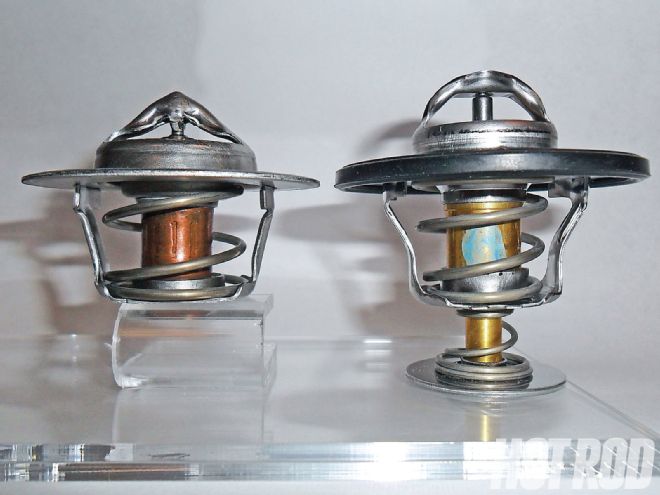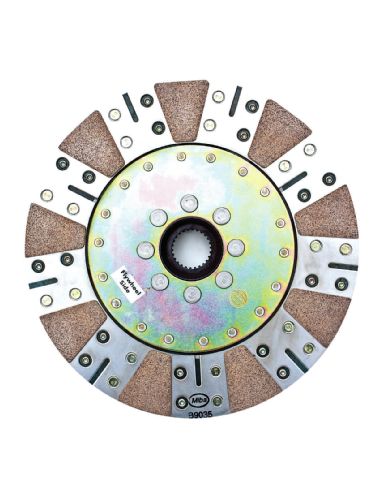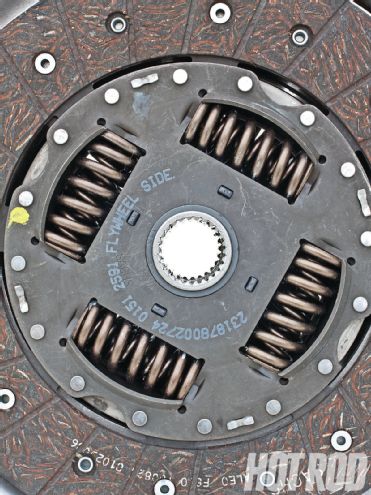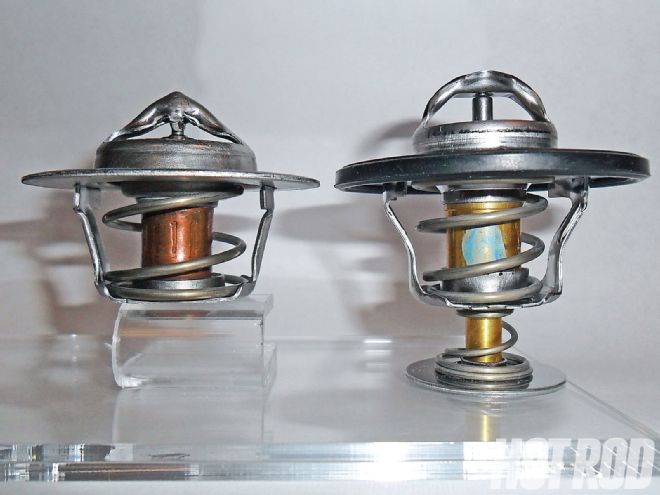
(Got a Question? [email protected])
Lynn Asks:
I have enjoyed reading the tech column in several recent HRMs concerning the '10 to '11 Camaros, particularly those related to readers' experiences when adding a turbo or supercharger to the 6.2L engine backed by the six-speed TR-6060 manual trans. Readers with those rides report about a 50 percent clutch failure rate when adding additional boost. With the '12 Camaro ZL1 slated to receive the Caddy CTS-V 550hp, supercharged LSA mill, is there any word regarding the General putting a beefier clutch behind the six-speed on that Caddy mill?
 This is one of the clutch discs from McLeod’s replacement ’10-’11 Camaro RXT dual-disc clutch and pressure plate kit. The entire assembly, including flywheel, can support 1,000 hp.
This is one of the clutch discs from McLeod’s replacement ’10-’11 Camaro RXT dual-disc clutch and pressure plate kit. The entire assembly, including flywheel, can support 1,000 hp.
Marlan Answers:
The present TR-6060-equipped Camaro with the naturally aspirated LS3 has a single-disc clutch that's good to around 500 hp or so (about a 20 percent cushion over the stock engine's output). Our inside sources tell us the supercharged LSA engine used in the Caddy CTS-V, as well as the forthcoming ZL1 Camaro, has or will have a dual-disc clutch with about 20 percent more holding power (about 700hp capacity).
Unfortunately, the stouter clutch is not a simple bolt-in behind the LS3. To install the Caddy clutch, you need a different flywheel, but because of the different number of crank-flange bolts, the Caddy flywheel won't fit. The LS3 has a six-bolt crankshaft flywheel mounting flange, the LSA has an eight-bolt flange, and the even stouter 638hp LS9 in the ZR1 Corvette has a nine-bolt flange. A different integral hydraulic release bearing is also needed. But the stock Caddy bearing has the wrong stack height to work with the Camaro bellhousing. If you change to the Cadillac bellhousing, the shifter handle comes out in the wrong place in the Camaro. The ZL1 Camaro is said to still use the Camaro-type bellhousing, with yet another different-height release bearing to make it work with the Camaro bell.
As of May 2011, the ZL1 Camaro parts haven't yet been released. You could use the Cadillac release bearing with a spacer, but that still doesn't solve the flywheel problem. But why obsess about stock (and usually fairly pricey) GM parts when the aftermarket outfits more than have the situation covered with 100 percent bolt-in solutions?
For example, Lingenfelter Performance has an integrated kit that bolts an LSA/LS9-level dual-disc clutch into the Camaro. The complete kit (PN L360020105)comes with a new six-bolt flywheel that matches the LS3's existing crank flange, two clutch discs, the pressure plate, the attaching bolts, a new integral hydraulic release bearing, and a spacer for the bearing so it fits the existing Camaro bellhousing. There are also upgraded clutch discs (PN L360050309) available that can withstand 960 lb-ft. But note that these are discs only, so for the best price, order the other parts in the complete kit individually so you don't end up with two extra, unneeded discs.
McLeod is yet another choice. It sells a 9-11/16-inch-od twin-disc RXT clutch kit and six-bolt flywheel. The stock flywheel was recessed, but McLeod's is flat. If you want the flywheel in steel, order PN 64055-00-07M; for aluminum, the kit is PN 63055-00-07M. Even though the stock, single-clutch disc is 11-5/8 inches in diameter, collectively the new, smaller discs generate 25 to 30 percent more square inches of holding power-- good enough, McLeod says, to support 1,000 hp. And you can use the original release bearing.
 Lingenfelter’s replacement ’10-’11 Camaro pressure plate and dual-disc clutch is based on GM LSA/LS9 technology. The kit includes a new flywheel and hydraulic release bearing as well. With optional upgraded discs, you’re looking at 960-lb-ft capability.
Lingenfelter’s replacement ’10-’11 Camaro pressure plate and dual-disc clutch is based on GM LSA/LS9 technology. The kit includes a new flywheel and hydraulic release bearing as well. With optional upgraded discs, you’re looking at 960-lb-ft capability.
Ford 429 Coolant Weepage
I have a '70 Mercury Cyclone with the original 429 CJ engine, manufactured in September 1969. I've owned it for 34 years. Everything is stock. For the last 20 years since I took the heads off, I have had minor coolant weepage at the front on both sides from the head gasket area. It is mostly just damp--maybe a drip if I drive it a ways; it does not squirt out. Since then I have tried stock Fel-Pro, high-perf Fel-Pro, and now Cometic head gaskets, as well as two sets of stock head bolts and even ARP studs--no change after four or five different repair attempts. A complete rebuild eight years ago found no cracks in the block or heads. The intake is not overtorqued. The engine runs great: There's no coolant ever in the oil, it never overheats, and it runs at 180 degrees here in Kansas City, even with the A/C on.
Was this a problem with early versions of this engine? There is a large coolant passage at the front of the block on both sides that in the new Ford high-perf blocks is now greatly reduced in size or has been moved elsewhere. Could this be related to my problem? Do you have any other ideas or suggestions?
Dave Robb
Olathe, KS
We haven't heard of any general weepage problems on these Ford engines. The new Ford high-perf blocks have reduced the size of the front coolant holes to primarily enhance cylinder wall integrity on extreme high-output engines, not to improve sealing. Besides, if there was seepage from the coolant transfer holes, the heads gaskets would likely show evidence of staining.
Have you checked the intake manifold corner studs? They go into the water jacket, and failure to properly seal these threads could let coolant work its way up the threads, where it would then seep down the front of the motor. Use Permatex thread sealant with PTFE or Gasgacinch to seal these threads.
Did the engine ever overheat? It so, the head and block decks could be warped. Or maybe in the past gasket residue was scraped off using a sanding disc or belt sander--this can end up taking more material off the edges or ends of the machined surface. In any event the two mating surfaces (head and block) should be flat within 0.002 inch (use a machinist straightedge and feeler gauges to check). Note, too, that the MLS-type head gaskets are more finicky about needing a flat, smooth deck surface compared with standard replacement composition gaskets. Be sure your torque wrench is accurate; over-tightening could also warp the heads. With stock 9/16-inch head bolts, the correct torque value is 120 lb-ft (aftermarket fasteners may differ).
Still leaking? There may be a small crack that didn't show up that last time the block was checked, particularly if the check was made on a cold block. Either pressure-test a complete hot engine or subject the block to magnetic particle inspection with the heads on and torqued, again with the surfaces warmed up to operating temperature.
 Cowden’s thermostat may not be closing all the way. The stock late-model GM thermostat is this two-stage, dual-spring design (right). For a simple, carbureted setup, use the early style single-stage thermostat (left). Photo: John Elway Chevrolet
Cowden’s thermostat may not be closing all the way. The stock late-model GM thermostat is this two-stage, dual-spring design (right). For a simple, carbureted setup, use the early style single-stage thermostat (left). Photo: John Elway Chevrolet
Too Much Radiator?
I have a '55 Chevy sedan with a 400hp '98 Vortec crate motor with a mild cam and a 600-cfm carb. The car has a huge aluminum radiator with dual cooling fans because it gets really hot down here. I run a 180-degree thermostat (which I've tested on the kitchen stove for accuracy) with a 3?16-inch hole for air relief.
My problem is that it won't get hot enough. Cruising at 60 mph (1,800 rpm) on an 80-degree day, it won't get above 150 degrees. I've clamped off the heater hoses--no change. I've changed the thermostat so many times all I have to do is raise the hood and the tools jump out and do it for me. The only thing that works is to cover half the radiator with cardboard--then it acts normal.
Is there such a thing as too much radiator?
Marv Cowden
Grand Prairie, TX
As long as you're running a conventional thermostat--one that's either fully open or fully closed--there's no such thing as "too much radiator." A conventional thermostat serves as a low-side limit switch. No coolant can circulate through the radiator as long as the thermostat remains completely closed. Therefore, the minimum system temperature cannot be less than (in your case) 180 degrees once the engine has reached operating temperature (believe me, there's no way a Chevy V8 will air-cool by itself sufficiently to keep the temp at 150 degrees for an extended time period).
I don't believe even your 3/16-inch air relief hole should make a significant difference, but why not try a thermostat without the hole? Also, depending on how the heater is plumbed, it can serve as an alternate coolant circulation path, but as you've said, clamping off the hoses made no difference. If it had made a difference, control valves are available that only permit circulation through the heater core when the heater is operating. So what's causing the problem? The thermostat may not be fully closed. Stock '96-'98 GM Vortec small-block engines use a two-stage thermostat with a variable opening rate. Compared with the classic style,, the new design is significantly longer with two springs instead of one. Get an old-school single-spring thermostat listed for a late '60s Chevy muscle car instead (180-degree, GM PN 10202456).
If it's not the thermostat then check to see if your temp gauge and/or the temp gauge sender are accurate. You can do this by temporarily hooking up an extra gauge, measuring the hot side of the radiator with a temperature gun (such as Intercomp PN 360018-E), or even inserting a simple meat thermometer between the fins on the radiator's hot side.